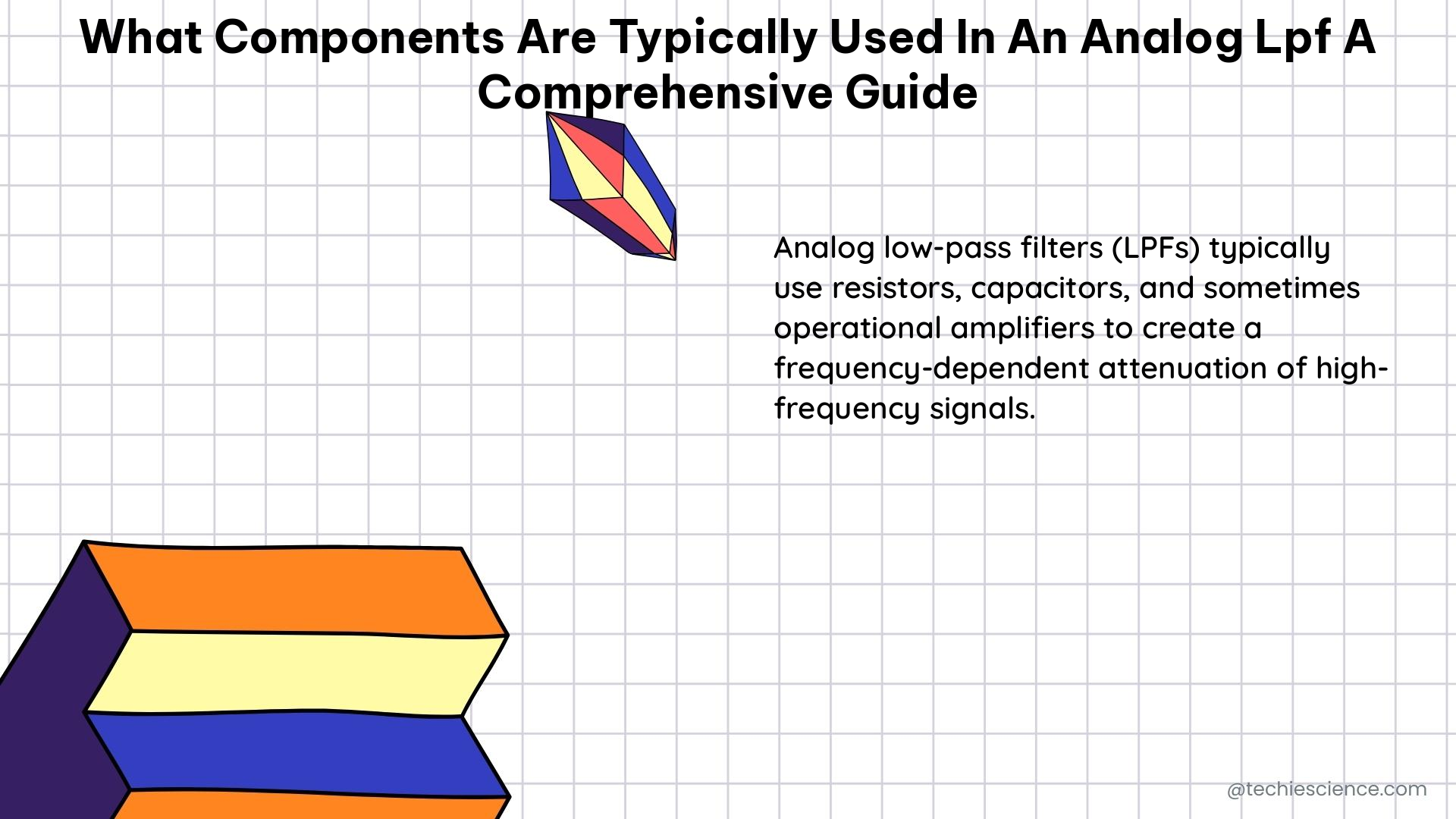In the design of an analog low-pass filter (LPF), there are several key components that are typically used, including resistors, capacitors, and operational amplifiers (op-amps). The specific values and characteristics of these components will depend on the desired cutoff frequency, filter order, and other specifications of the filter. This comprehensive guide will delve into the details of each component and how they contribute to the overall performance of an analog LPF.
Resistors
Resistors are a fundamental component in the design of an analog LPF. The resistance value, along with the capacitance, determines the cutoff frequency of the filter. The cutoff frequency (f_c) can be calculated using the formula:
f_c = 1 / (2 * π * R * C)
Where:
– R is the resistance in ohms
– C is the capacitance in farads
Typically, resistor values in the range of 1 kΩ to 100 kΩ are used in analog LPF designs. The specific resistance value will depend on the desired cutoff frequency and the capacitance value. For example, a 10 kΩ resistor paired with a 0.1 μF capacitor would result in a cutoff frequency of approximately 159 Hz.
It’s important to note that the resistor tolerance and temperature coefficient can also impact the filter’s performance. High-precision resistors with tight tolerances (e.g., 1% or 0.1%) and low temperature coefficients (e.g., ±50 ppm/°C) are often preferred to ensure consistent filter characteristics across a range of operating conditions.
Capacitors

Capacitors are the other key component in an analog LPF. The capacitance value, along with the resistance, determines the cutoff frequency of the filter. Commonly used capacitor values in analog LPF designs range from 0.01 μF to 10 μF, depending on the desired cutoff frequency and the resistor value.
The type of capacitor used can also impact the filter’s performance. Ceramic capacitors are often preferred due to their small size, low cost, and high reliability. However, film capacitors or electrolytic capacitors may be used in some applications, depending on the specific requirements.
It’s important to consider the capacitor’s voltage rating, temperature coefficient, and leakage characteristics when selecting the appropriate component. Capacitors with low voltage coefficients and low temperature coefficients are generally preferred to maintain consistent filter performance across a range of operating conditions.
Operational Amplifiers (Op-Amps)
In addition to resistors and capacitors, operational amplifiers (op-amps) are often used in the design of active analog LPFs. Op-amps can be used to provide signal amplification, impedance buffering, and active filtering capabilities.
The choice of op-amp will depend on the specific requirements of the filter, such as the required gain, the supply voltage, the frequency response, and the noise performance. Some common op-amp characteristics to consider include:
- Gain-Bandwidth Product (GBW): Determines the maximum frequency at which the op-amp can provide meaningful gain.
- Slew Rate: Measures the maximum rate of change of the op-amp’s output voltage, which can impact the filter’s transient response.
- Input Offset Voltage: Determines the DC offset at the op-amp’s output, which can affect the filter’s passband performance.
- Noise Performance: Characterizes the op-amp’s ability to amplify the signal without introducing excessive noise.
Popular op-amp choices for analog LPF designs include the TL071, LM324, and OPA2134, among others. The specific op-amp selection will depend on the filter’s requirements and the designer’s preferences.
Filter Topologies
There are several common analog LPF topologies that utilize the components discussed above, including:
- Passive RC LPF: A simple first-order LPF consisting of a resistor and a capacitor in series.
- Active Sallen-Key LPF: A second-order LPF that uses an op-amp, two resistors, and two capacitors.
- Active Multiple Feedback (MFB) LPF: A second-order LPF that uses an op-amp, three resistors, and two capacitors.
- Active State-Variable LPF: A higher-order LPF that uses an op-amp, four resistors, and two capacitors.
The choice of filter topology will depend on the desired filter order, frequency response characteristics, and other design requirements. Each topology has its own advantages and trade-offs in terms of complexity, component count, and performance.
Filter Design Tables and Tools
When designing an analog LPF, it can be helpful to refer to design tables and tools that provide the necessary component values for a given set of specifications. Two useful resources are:
- Analog Filter Design Demystified: This article from Maxim Integrated provides design tables for Butterworth, Chebyshev, and Bessel LPFs, including the component values for various filter orders.
- Oxeltech Filter Design Tool: This online tool from Oxeltech allows you to select the filter response, topology, and other parameters, and it will automatically calculate the required resistor and capacitor values, as well as provide a full bill of materials.
These resources can be invaluable when designing and optimizing analog LPF circuits for your specific applications.
Conclusion
In summary, the key components used in the design of an analog LPF are resistors, capacitors, and op-amps. The specific values and characteristics of these components will depend on the desired cutoff frequency, filter order, and other performance requirements. By understanding the role of each component and the available design resources, you can create effective and efficient analog LPF circuits for a wide range of applications.
References
- Oxeltech. (2022-04-09). Your Ultimate Guide to Designing Analog Filters. Retrieved from https://oxeltech.de/en/analog-filters-design-guide/
- Maxim Integrated. (2003-02-13). Analog Filter Design Demystified. Retrieved from https://www.analog.com/en/resources/technical-articles/analog-filter-design-demystified.html
- Texas Instruments. (n.d.). Active Low-Pass Filter Design (Rev. D). Retrieved from https://www.ti.com/lit/an/sloa049d/sloa049d.pdf?ts=1705382732945

The lambdageeks.com Core SME Team is a group of experienced subject matter experts from diverse scientific and technical fields including Physics, Chemistry, Technology,Electronics & Electrical Engineering, Automotive, Mechanical Engineering. Our team collaborates to create high-quality, well-researched articles on a wide range of science and technology topics for the lambdageeks.com website.
All Our Senior SME are having more than 7 Years of experience in the respective fields . They are either Working Industry Professionals or assocaited With different Universities. Refer Our Authors Page to get to know About our Core SMEs.